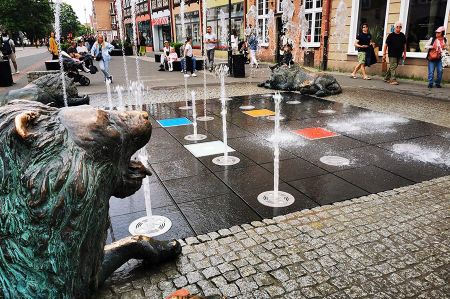Gdansk - Walk from the Lion Fountain to Long Lane
- Written by Portal Editor
We were in Poland again for a family communion and, despite the late hour and rainy weather, we wanted to take a short trip to the city centre of Gdansk.
In what is now Polish Gdansk, or rather Gdansk, most of the architecturally so attractive and magnificent patrician houses were built in the 16th century. They were almost completely destroyed in the Second World War, but were lovingly and meticulously restored in the centre. The Polish restorers have accomplished a real masterpiece here!
Brief excursion into the history of the city of Gdansk
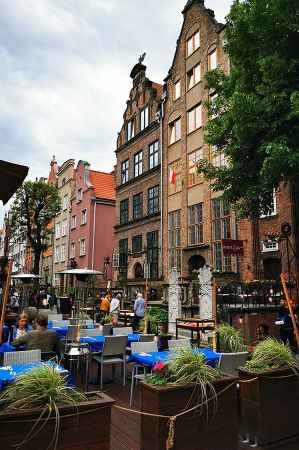 The history of Gdansk, the Hanseatic city that is around 1,000 years old, can certainly be described as changeable.
The history of Gdansk, the Hanseatic city that is around 1,000 years old, can certainly be described as changeable.
The city was under the rule of Slavic princes, the Teutonic Order of Knights, the Polish crown.
Gdansk once belonged to Prussia and became the "Free City of Gdansk" from 1920-1939.
On September 1, 1939, the Second World War began on the Westerplatte peninsula in the north of the city of Danzig, one of the city's main tourist attractions, despite the fact that 79 years have passed.
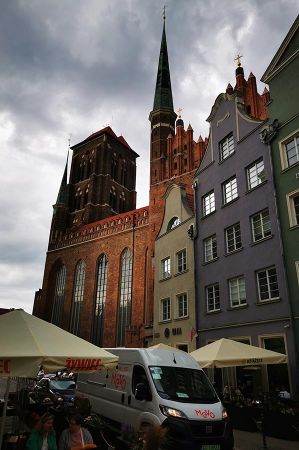 The Free City of Danzig, with over 90 percent of the German population, was incorporated into the German Reich by the Nazis. Polish-speaking residents were subsequently massively harassed, and some were even killed.
The Free City of Danzig, with over 90 percent of the German population, was incorporated into the German Reich by the Nazis. Polish-speaking residents were subsequently massively harassed, and some were even killed.
At the end of March 1945, Allied air raids on Danzig began, followed by ground fighting when the Red Army invaded. The city's buildings and parks were partially destroyed. Before and during the fighting, the German-speaking population was evacuated and fled westwards.
The castle was also damaged in the fighting and burned down.
Start of our tour at the Lion Fountain
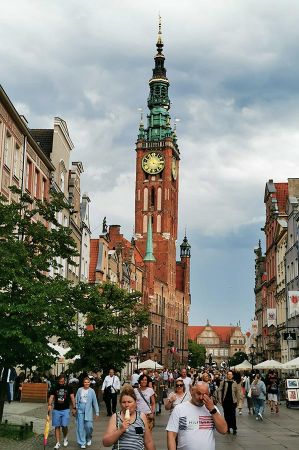 We found a parking space relatively quickly and were thus able to start our tour near the fountain ensemble consisting of 24 water jets and four massive lions. The fountain is guarded by four lions, with the "lion" being the heraldic animal of the Hanseatic city. However, the so-called "Gdansk lions" are also a product of the Gdansk Tourist Organization (GOT), which consists of bronze lion figures measuring just 50 cm. Where did the idea for "new" lions in Gdansk come from?
We found a parking space relatively quickly and were thus able to start our tour near the fountain ensemble consisting of 24 water jets and four massive lions. The fountain is guarded by four lions, with the "lion" being the heraldic animal of the Hanseatic city. However, the so-called "Gdansk lions" are also a product of the Gdansk Tourist Organization (GOT), which consists of bronze lion figures measuring just 50 cm. Where did the idea for "new" lions in Gdansk come from?
Firstly, the lion is actually part of the Gdansk city coat of arms! Lions have had a permanent place in it for almost 550 years. In the 15th century, the Polish King Casimir IV Andrew (known as the Jagiellonian) granted Gdansk a privilege according to which the city was granted the right to use the royal crown accompanied by two crosses in its coat of arms. From this point on, the coat of arms of the city of Gdansk is held by two stately lions.
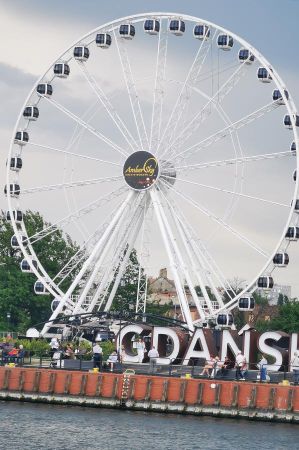 The square floor of this facility consists of four differently coloured coverings. They are intended to symbolize the four historical quarters of the Gdansk Legal City, which meet at this point. At night, a play of colours illuminates the fountain. Before Gdansk was destroyed during World War II, a historic fountain with four figures stood on this spot. It was intended to commemorate the appointment of Frederick I as King of Prussia, announced by four heralds. Behind the fountain stands the Baroque Royal Chapel.
The square floor of this facility consists of four differently coloured coverings. They are intended to symbolize the four historical quarters of the Gdansk Legal City, which meet at this point. At night, a play of colours illuminates the fountain. Before Gdansk was destroyed during World War II, a historic fountain with four figures stood on this spot. It was intended to commemorate the appointment of Frederick I as King of Prussia, announced by four heralds. Behind the fountain stands the Baroque Royal Chapel.
The Lion Castle was designed by Hans Kramer (master builder) and built in 1569. The house got its name from the lion sculptures in the Mannerist main portal of the house, which were probably previously located in the annex of the house. The Lion Castle belonged to the Schwartzwald family and was a meeting place for Gdansk artists and scholars. In 1636, the King of Poland, Władysław IV Vasa, stayed in the Lion Castle. The house has one of the most beautiful halls in Gdansk.
Now we go to the Crane Gate on the Motlawa
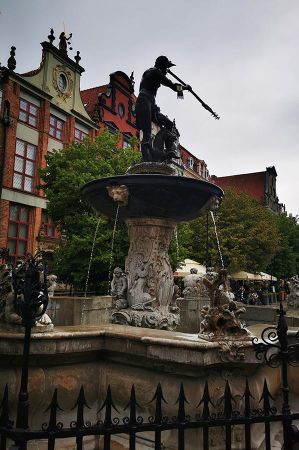 The Crane Gate on the Motlawa in the harbour is world famous and one of the landmarks of Gdansk. It is actually "just" a city gate, but it probably only became known because of its crane function.
The Crane Gate on the Motlawa in the harbour is world famous and one of the landmarks of Gdansk. It is actually "just" a city gate, but it probably only became known because of its crane function.
The huge freight elevator with its wheels was used to load and unload ships. Such a structure already existed in the middle of the 14th century, but was not built in its current form until 1444.
After it burned down almost completely in 1945, it was renovated again from 1957-59 and now houses the Gdansk Maritime Museum.
We continue to the Artus Court
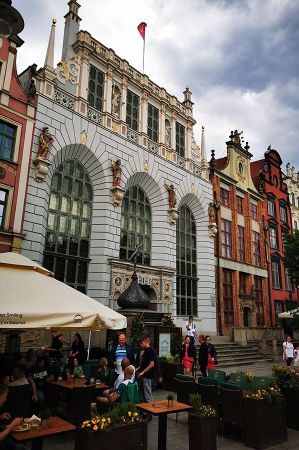 The Artus Court is also one of the landmarks of Gdansk. It is located on the Long Market (Dlugi Targ), probably the most beautiful square in the city.
The Artus Court is also one of the landmarks of Gdansk. It is located on the Long Market (Dlugi Targ), probably the most beautiful square in the city.
It was once the seat of the Gdansk Stock Exchange and served as a meeting place for the wealthy merchants of the time. The interior is artistically decorated.
The Artus Court only received its magnificent facade in 1552, after it was rebuilt in the Renaissance style. In front of the building is the Neptune Fountain - a monument in honour of the sea god Neptune.
Walk through Long Lane
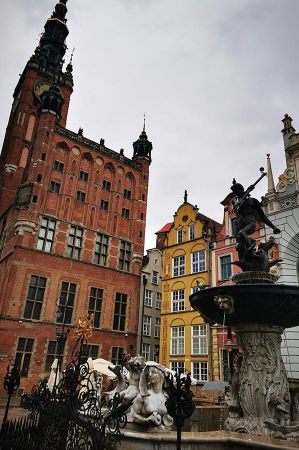 The Long Lane, also called Long Lane, is the city's main street. It ends at the Long Market - both together are also called King's Street. Although the street was almost completely destroyed in World War II, you can no longer tell this today. It has been artfully restored - at least as far as the facades are concerned. A stroll along this street is an absolute must for every visitor to Gdansk. One building, more beautiful than the next, is lined up here. For example, the Dyer's House, the Schumann House, the Lion's Castle...
The Long Lane, also called Long Lane, is the city's main street. It ends at the Long Market - both together are also called King's Street. Although the street was almost completely destroyed in World War II, you can no longer tell this today. It has been artfully restored - at least as far as the facades are concerned. A stroll along this street is an absolute must for every visitor to Gdansk. One building, more beautiful than the next, is lined up here. For example, the Dyer's House, the Schumann House, the Lion's Castle...
Gdansk also has an important place in more recent history. In 1980, the trade union "Solidarnosc" was founded here, which was led by Lech Walesa - the later President of Poland. A visit to the suburb of Oliwa with the monastery church, where organ concerts are held almost daily, is also worthwhile, but we will come to that later. Together with Sopot and Gdynia, it forms the so-called "Tricity".
Our first impressions of the city centre were so impressive that we decided to plan another visit soon, if our schedule allows. Unfortunately, the rain was also largely responsible for our pictures being a bit dark and less vivid. We apologize for this.
We can only recommend the city centre with its really impressive buildings, the many sights and its really great restaurants and cafes - an absolutely worthwhile travel destination.
Please read as well:
Egyptian collection in the Musée d’Arts Africains & Océaniens
Cosplay, manga, anime - at the Leipzig Book Fair
-
 First Hike through inner city of Gdansk
First Hike through inner city of Gdansk
First Hike through inner city of Gdansk
First Hike through inner city of Gdansk
-
 First Hike through inner city of Gdansk
First Hike through inner city of Gdansk
First Hike through inner city of Gdansk
First Hike through inner city of Gdansk
-
 First Hike through inner city of Gdansk
First Hike through inner city of Gdansk
First Hike through inner city of Gdansk
First Hike through inner city of Gdansk
-
 First Hike through inner city of Gdansk
First Hike through inner city of Gdansk
First Hike through inner city of Gdansk
First Hike through inner city of Gdansk
-
 First Hike through inner city of Gdansk
First Hike through inner city of Gdansk
First Hike through inner city of Gdansk
First Hike through inner city of Gdansk
-
 First Hike through inner city of Gdansk
First Hike through inner city of Gdansk
First Hike through inner city of Gdansk
First Hike through inner city of Gdansk
-
 First Hike through inner city of Gdansk
First Hike through inner city of Gdansk
First Hike through inner city of Gdansk
First Hike through inner city of Gdansk
-
 First Hike through inner city of Gdansk
First Hike through inner city of Gdansk
First Hike through inner city of Gdansk
First Hike through inner city of Gdansk
-
 First Hike through inner city of Gdansk
First Hike through inner city of Gdansk
First Hike through inner city of Gdansk
First Hike through inner city of Gdansk
-
 First Hike through inner city of Gdansk
First Hike through inner city of Gdansk
First Hike through inner city of Gdansk
First Hike through inner city of Gdansk
-
 First Hike through inner city of Gdansk
First Hike through inner city of Gdansk
First Hike through inner city of Gdansk
First Hike through inner city of Gdansk
-
 First Hike through inner city of Gdansk
First Hike through inner city of Gdansk
First Hike through inner city of Gdansk
First Hike through inner city of Gdansk
-
 First Hike through inner city of Gdansk
First Hike through inner city of Gdansk
First Hike through inner city of Gdansk
First Hike through inner city of Gdansk
-
 First Hike through inner city of Gdansk
First Hike through inner city of Gdansk
First Hike through inner city of Gdansk
First Hike through inner city of Gdansk
-
 First Hike through inner city of Gdansk
First Hike through inner city of Gdansk
First Hike through inner city of Gdansk
First Hike through inner city of Gdansk
-
 First Hike through inner city of Gdansk
First Hike through inner city of Gdansk
First Hike through inner city of Gdansk
First Hike through inner city of Gdansk
-
 First Hike through inner city of Gdansk
First Hike through inner city of Gdansk
First Hike through inner city of Gdansk
First Hike through inner city of Gdansk
-
 First Hike through inner city of Gdansk
First Hike through inner city of Gdansk
First Hike through inner city of Gdansk
First Hike through inner city of Gdansk
-
 First Hike through inner city of Gdansk
First Hike through inner city of Gdansk
First Hike through inner city of Gdansk
First Hike through inner city of Gdansk
-
 First Hike through inner city of Gdansk
First Hike through inner city of Gdansk
First Hike through inner city of Gdansk
First Hike through inner city of Gdansk
-
 First Hike through inner city of Gdansk
First Hike through inner city of Gdansk
First Hike through inner city of Gdansk
First Hike through inner city of Gdansk
https://www.alaturka.info/en/poland/gdansk/6678-gdansk-walk-from-the-lion-fountain-to-long-lane#sigProId49ad7b9403
